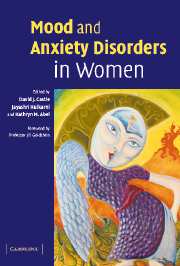Book contents
- Frontmatter
- Contents
- Contributors
- Preface
- Foreword
- 1 Pubertal development and the emergence of the gender gap in mood disorders: A developmental and evolutionary synthesis
- 2 Borderline personality disorder: Sex differences
- 3 Substance use and abuse in women
- 4 Anxiety disorders in women
- 5 Posttraumatic stress disorder in women
- 6 Domestic violence and its impact on mood disorder in women: Implications for mental health workers
- 7 Depression in women: Hormonal influences
- 8 Anxiety and mood disorders in pregnancy and the postpartum period
- 9 Pharmacological treatment of anxiety and depression in pregnancy and lactation
- 10 Bipolar affective disorder: Special issues for women
- 11 Mood and menopause
- 12 Anxiety and depression in women in old age
- Index
5 - Posttraumatic stress disorder in women
Published online by Cambridge University Press: 13 August 2009
- Frontmatter
- Contents
- Contributors
- Preface
- Foreword
- 1 Pubertal development and the emergence of the gender gap in mood disorders: A developmental and evolutionary synthesis
- 2 Borderline personality disorder: Sex differences
- 3 Substance use and abuse in women
- 4 Anxiety disorders in women
- 5 Posttraumatic stress disorder in women
- 6 Domestic violence and its impact on mood disorder in women: Implications for mental health workers
- 7 Depression in women: Hormonal influences
- 8 Anxiety and mood disorders in pregnancy and the postpartum period
- 9 Pharmacological treatment of anxiety and depression in pregnancy and lactation
- 10 Bipolar affective disorder: Special issues for women
- 11 Mood and menopause
- 12 Anxiety and depression in women in old age
- Index
Summary
The diagnosis of posttraumatic stress disorder (PTSD) has been the focus of considerable attention since it first appeared in the diagnostic nomenclature in 1980. Since that time, the diagnostic criteria have been refined, with both the diagnostic and statistical manual of mental disorders DSM-IV (American Psychiatric Association, 1994) and international classification of diseases (ICD-10) (World Health Organization, 1993) recognizing the condition. In recent years, a major focus of interest has been the impact of gender on the risk of developing PTSD and related conditions following traumatic exposure. Indeed, the fact that a whole book has recently been devoted to a comprehensive review of issues concerning PTSD and gender (Kimerling et al., 2002) is an indication of the importance placed on this relationship. While interested readers are referred to that volume for a more in-depth analysis of the area, the purpose of this chapter is to provide an overview of the key issues concerning women and PTSD.
The nature of PTSD
The first criterion to be met for a diagnosis of PTSD is the experience of a traumatic event (Criterion A1), usually defined as involving actual or threatened physical threat to the self or others. The person's response to the event must have involved a powerful emotional reaction, such as fear, helplessness, or horror (Criterion A2). Three broad clusters of symptoms characterize the disorder and are required in some form for a diagnosis. First, evidence of re-experiencing the trauma is required (known as the “B criteria”).
Keywords
- Type
- Chapter
- Information
- Mood and Anxiety Disorders in Women , pp. 75 - 91Publisher: Cambridge University PressPrint publication year: 2006

